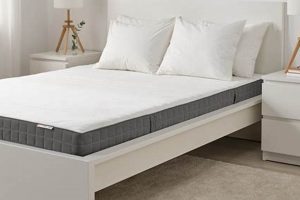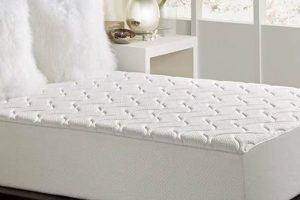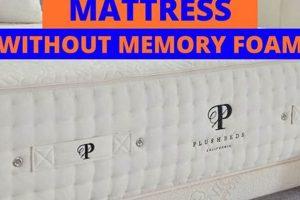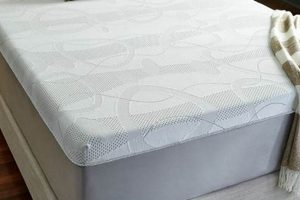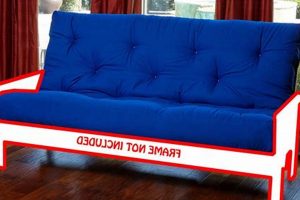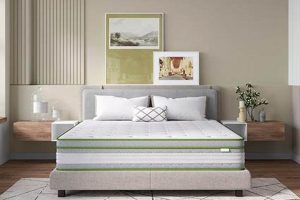The lifespan of viscoelastic foam bedding is a key consideration for consumers. This refers to the period for which the product maintains its intended comfort and support characteristics without significant degradation. Factors influencing this duration include foam density, manufacturing quality, usage patterns, and environmental conditions.
A durable sleep surface offers sustained value, minimizing the need for frequent replacements. Historically, mattress materials had shorter usable lives, requiring more frequent purchases. Modern foam formulations and construction techniques aim to extend this period, contributing to cost savings and reduced environmental impact through decreased landfill waste.
Understanding the variables that affect how long a viscoelastic foam mattress retains its properties is crucial for making informed purchasing decisions and implementing proper maintenance practices to maximize its service life. Key aspects include material composition, weight distribution, and proactive measures against wear and tear.
Enhancing Viscoelastic Foam Bedding Lifespan
Optimizing the useful life of a viscoelastic foam mattress requires adherence to specific maintenance practices and a thorough understanding of factors contributing to wear. Implementing the following guidelines can significantly extend the period of optimal performance.
Tip 1: Employ a Supportive Foundation: Utilize a solid, even foundation or bed frame. Inadequate support places undue stress on specific areas of the mattress, accelerating degradation and potentially voiding warranties.
Tip 2: Rotate Regularly: Rotate the mattress 180 degrees every three to six months. This distributes weight more evenly, preventing localized compression and prolonging the overall structural integrity.
Tip 3: Utilize a Mattress Protector: A high-quality, waterproof mattress protector shields against spills, stains, and dust mites. Protecting the foam from moisture and allergens is crucial in preserving its integrity and hygiene.
Tip 4: Control the Environment: Maintain a consistent and moderate room temperature and humidity level. Extreme heat or humidity can degrade the foam’s structure and lead to premature breakdown.
Tip 5: Minimize Direct Sunlight Exposure: Prolonged exposure to direct sunlight can damage the foam. Utilize window coverings to mitigate ultraviolet radiation, particularly during peak sunlight hours.
Tip 6: Adhere to Weight Recommendations: Do not exceed the manufacturer’s recommended weight limits for the mattress. Overloading the mattress compromises its support structure and reduces its lifespan.
Tip 7: Practice Proper Cleaning: Vacuum the mattress surface regularly using an upholstery attachment to remove dust and debris. Address spills immediately with a damp cloth and mild detergent, avoiding excessive moisture penetration.
Implementing these preventative measures and adhering to manufacturer guidelines will maximize the functional duration of viscoelastic foam bedding, yielding a longer-lasting and more comfortable sleep experience.
The subsequent sections will address the internal factors, such as foam density and composition, that contribute to the inherent durability of these mattresses.
1. Foam Density
Foam density serves as a primary determinant of the overall lifespan of a viscoelastic foam mattress. It represents the mass of the foam per unit volume, typically measured in pounds per cubic foot (lbs/ft). Higher density generally indicates a greater concentration of material, leading to enhanced durability and resistance to compression over time.
- Support and Resistance to Compression
Higher density foams exhibit superior support capabilities and a greater capacity to resist compression. This translates to less sagging and indentation over prolonged use. For example, a mattress with a 5 lb/ft foam will maintain its shape and support characteristics for a longer duration compared to a 3 lb/ft foam under similar conditions.
- Durability and Longevity
Increased density directly correlates with enhanced durability. The foam’s ability to withstand repeated stress and pressure from body weight is significantly improved. Mattresses with higher density foams are less prone to developing soft spots or losing their original firmness, thereby extending their useful life.
- Resistance to Degradation
Denser foams are more resistant to environmental factors such as temperature fluctuations and humidity. The compact structure reduces the rate of oxidation and breakdown of the foam’s polymer matrix, contributing to its long-term stability and preventing premature deterioration.
- Weight Capacity and Performance
Mattresses incorporating higher density foams generally offer a greater weight capacity without compromising support. This is particularly crucial for individuals of larger stature. A higher density foam provides consistent performance and minimizes the risk of bottoming out or experiencing diminished comfort levels over time.
In summary, foam density is a critical parameter influencing viscoelastic foam mattress longevity. Higher density foams offer improved support, durability, resistance to degradation, and enhanced weight capacity, ultimately contributing to a longer-lasting and more comfortable sleep surface. Lower density foams tend to degrade more quickly, leading to a shorter lifespan and reduced user satisfaction.
2. Material Composition
The longevity of viscoelastic foam mattresses is intrinsically linked to their material composition. The specific polymers, additives, and manufacturing processes employed significantly influence the product’s durability, comfort, and resistance to degradation over time. Careful selection and formulation of these materials are essential to maximizing mattress lifespan.
- Polyurethane Polymer Blends
The primary component, polyurethane, is often blended with other polymers to achieve specific performance characteristics. The type and ratio of these polymers directly impact the foam’s density, resilience, and resistance to deformation. Higher quality, more resilient polymer blends contribute to enhanced durability and reduced sagging, thereby extending the mattress’s usable life. Low-grade polymer blends degrade faster and lead to premature mattress failure.
- Additives and Stabilizers
A range of additives, including antioxidants, UV stabilizers, and flame retardants, are incorporated into the foam formulation. Antioxidants mitigate oxidative degradation, UV stabilizers protect against sunlight-induced breakdown, and flame retardants comply with safety regulations. The quality and conc
entration of these additives significantly impact the foam’s long-term stability and resistance to environmental stressors, affecting its lifespan. Inadequate stabilization leads to accelerated deterioration and reduced longevity. - Viscoelastic Agents
The viscoelastic properties of the foam, responsible for its characteristic slow response and pressure-relieving qualities, are determined by specific chemical agents added during manufacturing. These agents influence the foam’s ability to conform to the body and return to its original shape. Optimal viscoelasticity is crucial for maintaining comfort and support over time. Degradation or breakdown of these agents results in diminished comfort and accelerated wear.
- Density Modifiers and Fillers
Density modifiers and fillers may be added to adjust the foam’s density, firmness, and cost. However, the type and quantity of these fillers can impact the mattress’s longevity. High-quality, inert fillers can enhance the foam’s overall stability, while low-quality or excessive fillers can compromise its structural integrity and accelerate degradation. In particular, excessive use of low-cost fillers can significantly reduce the mattress’s lifespan.
In conclusion, the material composition of a viscoelastic foam mattress is a critical determinant of its longevity. The careful selection and formulation of polyurethane polymer blends, additives, viscoelastic agents, and density modifiers directly influence the mattress’s durability, comfort, and resistance to degradation. Mattresses constructed from high-quality materials, properly formulated and processed, offer significantly longer lifespans and sustained performance compared to those made from inferior materials.
3. Foundation Quality
The support system beneath a viscoelastic foam mattress, commonly referred to as the foundation, plays a crucial role in determining its longevity. An inadequate or incompatible foundation can accelerate wear and compromise the mattress’s structural integrity, directly impacting its lifespan and performance.
- Even Weight Distribution
A high-quality foundation provides uniform support across the entire mattress surface, preventing localized stress and sagging. Solid platforms, closely spaced slats, or adjustable bases designed for foam mattresses ensure weight is distributed evenly. Conversely, foundations with wide gaps, uneven surfaces, or inadequate support structures create pressure points, leading to premature compression and deformation of the foam layers.
- Ventilation and Airflow
Certain foundations facilitate airflow beneath the mattress, mitigating moisture accumulation and preventing mold or mildew growth. Slat systems with sufficient spacing and breathable platform designs contribute to a drier, more hygienic sleep environment. Inadequate ventilation traps moisture, potentially degrading the foam and reducing its lifespan. Solid, non-breathable foundations may require additional measures to ensure adequate airflow.
- Structural Stability and Support
A robust foundation offers stable support, preventing excessive motion transfer and ensuring proper spinal alignment. Solid wood frames, reinforced metal structures, and adjustable bases with reliable mechanisms provide consistent support over time. Weak or unstable foundations can cause the mattress to shift or sag, compromising its comfort and structural integrity. Inadequate support can lead to premature wear and reduced lifespan.
- Compatibility with Mattress Type
Foundations should be specifically designed or recommended for use with viscoelastic foam mattresses. Some foundations, such as box springs, may not provide adequate support for foam mattresses and can damage the foam layers. Platform beds, adjustable bases, and slat systems with appropriate spacing are generally considered compatible options. Using an incompatible foundation can void warranties and significantly reduce the mattress’s lifespan.
In summary, foundation quality is a pivotal factor influencing viscoelastic foam mattress longevity. An appropriate foundation promotes even weight distribution, adequate ventilation, structural stability, and compatibility with the mattress type, collectively contributing to a longer-lasting and more comfortable sleep experience. Conversely, an inadequate foundation can accelerate wear, compromise support, and significantly reduce the mattress’s lifespan.
4. Usage Patterns
The manner in which a viscoelastic foam mattress is utilized directly influences its lifespan. Usage patterns encompass factors such as body weight, sleeping position, frequency of use, and activities conducted on the mattress. These elements collectively exert mechanical stress that contributes to the gradual degradation of the foam structure, ultimately affecting how long the mattress retains its original comfort and support characteristics. Heavier individuals, for instance, impart greater compressive forces, accelerating foam breakdown compared to lighter individuals. Similarly, consistent sleep in a specific area of the mattress can create localized indentations, reducing overall support and promoting uneven wear. Active use beyond sleep, such as prolonged sitting or children jumping on the mattress, further amplifies these effects.
Understanding these connections has practical implications for prolonging mattress life. Regularly rotating the mattress mitigates localized wear by distributing pressure more evenly across the surface. Using the mattress solely for sleep, rather than as a general-purpose surface, reduces unnecessary stress. Employing a mattress protector safeguards against spills and stains, preventing moisture-related degradation of the foam. Addressing these usage-related variables provides consumers with actionable strategies for maximizing the investment in their viscoelastic foam mattress. For instance, a couple with a significant weight difference might consider a higher density foam mattress to compensate for the greater stress exerted by the heavier individual.
In conclusion, usage patterns represent a crucial determinant of viscoelastic foam mattress longevity. Body weight, sleeping position, frequency of use, and activities conducted on the mattress all contribute to the rate of foam degradation. By recognizing and proactively addressing these usage-related factors, consumers can significantly extend the serviceable life of their mattress, ensuring sustained comfort and support for a longer period. Ignoring these considerations leads to accelerated wear and premature replacement, highlighting the practical significance of this understanding.
5. Maintenance Practices
Routine and consistent upkeep directly impacts the sustained performance and lifespan of viscoelastic foam mattresses. Adherence to recommended procedures mitigates wear, prevents degradation, and preserves the intended comfort and support characteristics, ultimately influencing how long the mattress remains serviceable.
- Regular Rotation and Flipping
Rotating the mattress, typically every
three to six months, distributes weight more evenly, preventing localized compression and sagging. For models designed to be flipped, this practice further equalizes wear on both surfaces. These actions reduce the development of indentations and prolong the overall structural integrity. Mattresses not rotated or flipped tend to degrade unevenly, leading to premature loss of support and a shorter lifespan. - Protective Encasements and Covers
Utilizing a high-quality, waterproof mattress protector shields the foam from spills, stains, and dust mites. These covers form a barrier against moisture penetration, preventing mold and mildew growth within the foam layers. Furthermore, encasements protect against allergens, creating a healthier sleep environment and prolonging the mattress’s hygienic integrity. Absence of such protection accelerates degradation and necessitates more frequent replacement.
- Proper Cleaning Procedures
Regular vacuuming removes dust, debris, and dead skin cells that accumulate on the mattress surface. Addressing spills promptly with a damp cloth and mild detergent prevents permanent staining and avoids moisture saturation. Harsh chemicals and excessive moisture should be avoided, as they can damage the foam’s cellular structure. Neglecting cleaning allows allergens to accumulate and can lead to the breakdown of foam components, reducing mattress longevity.
- Foundation and Support Inspection
Periodically inspecting the mattress foundation ensures adequate and even support. Sagging or damaged foundations compromise the mattress’s structural integrity, leading to uneven wear and potential damage. Repairing or replacing inadequate foundations prevents premature mattress failure and maintains optimal support throughout its lifespan. A stable foundation is critical for maximizing the mattress’s durability and comfort.
Consistent implementation of these maintenance practices significantly extends the functional lifespan of viscoelastic foam bedding. These procedures mitigate wear, prevent degradation, and preserve hygiene, ultimately maximizing the return on investment and ensuring a longer-lasting, more comfortable sleep experience. Neglecting these practices accelerates deterioration and reduces the mattress’s ability to provide optimal support and comfort over time.
6. Environmental Factors
Environmental conditions significantly influence the lifespan of viscoelastic foam mattresses. Temperature, humidity, and exposure to sunlight are primary factors that contribute to the material’s degradation over time. High temperatures accelerate the breakdown of the foam’s polymer structure, leading to a loss of elasticity and support. Similarly, elevated humidity levels promote moisture absorption, creating an environment conducive to mold and mildew growth within the mattress. These microorganisms compromise the foam’s integrity, resulting in premature deterioration and reduced comfort. Direct and prolonged exposure to sunlight introduces ultraviolet radiation, which further accelerates the degradation process. For example, a mattress placed near a window without UV-blocking curtains will likely exhibit a shorter lifespan compared to one shielded from direct sunlight. Understanding these effects has practical significance for consumers seeking to maximize mattress longevity.
Proper environmental control can mitigate these detrimental effects. Maintaining a stable and moderate room temperature, ideally between 60 and 75 degrees Fahrenheit, minimizes thermal stress on the foam. Utilizing a dehumidifier in humid climates reduces moisture accumulation within the mattress, preventing microbial growth. Employing blackout curtains or UV-blocking window films minimizes exposure to harmful ultraviolet radiation. Furthermore, ensuring adequate ventilation around the mattress facilitates air circulation, reducing the risk of moisture buildup. These measures represent proactive strategies for safeguarding the mattress against environmental damage. Consider, for instance, a mattress stored in a damp basement versus one kept in a climate-controlled bedroom; the latter will demonstrably exhibit a longer usable life.
In summary, environmental factors constitute a critical determinant of viscoelastic foam mattress longevity. Temperature, humidity, and sunlight exposure collectively contribute to the material’s degradation, impacting its comfort and support characteristics. By implementing appropriate environmental controls and protective measures, consumers can significantly extend the mattress’s lifespan, ensuring sustained performance and value. Recognizing the practical significance of these factors allows for informed decisions and proactive interventions that mitigate environmental risks and maximize mattress durability.
Frequently Asked Questions
This section addresses common inquiries regarding the factors influencing the usable life of viscoelastic foam mattresses. The information presented aims to provide clarity and inform decision-making related to mattress selection and maintenance.
Question 1: What is the average lifespan one can expect from a viscoelastic foam mattress?
The average lifespan typically ranges from seven to ten years, contingent upon foam density, usage patterns, and adherence to recommended maintenance practices. Higher density foams and diligent upkeep contribute to extended durability.
Question 2: Does foam density directly correlate with mattress durability?
Yes, a direct correlation exists. Higher density foams generally exhibit greater resistance to compression and degradation, resulting in prolonged structural integrity and extended lifespan.
Question 3: How does the type of foundation impact the longevity of a viscoelastic foam mattress?
An appropriate foundation provides even support, preventing localized stress and sagging. Inadequate or incompatible foundations can accelerate wear and compromise the mattress’s structural integrity, reducing its lifespan.
Question 4: What maintenance practices are most effective in prolonging the life of a viscoelastic foam mattress?
Regular rotation, the use of a protective mattress cover, and consistent vacuuming are crucial for mitigating wear and preventing degradation. These practices preserve hygiene and extend the mattress’s usable life.
Question 5: Can environmental factors significantly affect mattress longevity?
Yes, environmental conditions such as high humidity, temperature extremes, and direct sunlight exposure can accelerate the breakdown of foam materials, reducing mattress lifespan. Mitigation strategies are advised.
Question 6: Is it possible to restore a sagging viscoelastic foam mattress?
While minor sagging may be temporarily addressed with mattress toppers or rotation, significant and irreversible sagging typically indicates that the mattress has reached the end of its serviceable life and requires replacement.
In conclusion, understanding the factors influencing the lifespan of viscoelastic foam mattresses empowers informed decision-making and promotes responsible mattress care. Adherence to recommended practices maximizes the investment and ensures sustained comfort and support.
The subsequent section will explore specific indicators of mattress wear and the optimal timing for replacement.
Memory Foam Mattress Longevity
This exploration has detailed the multifaceted nature of memory fo
am mattress longevity. Density, material composition, foundation quality, usage patterns, maintenance practices, and environmental factors collectively dictate the lifespan of these bedding products. Understanding and addressing these elements are crucial for consumers seeking to maximize their investment and ensure sustained comfort and support.
The lifespan of a viscoelastic foam mattress is not predetermined, but rather a result of informed choices and diligent care. As technology advances, future iterations may offer enhanced durability; however, the principles outlined herein will remain relevant in optimizing the serviceable life of these sleep surfaces. Responsible ownership ensures both economic value and enhanced sleep quality.


